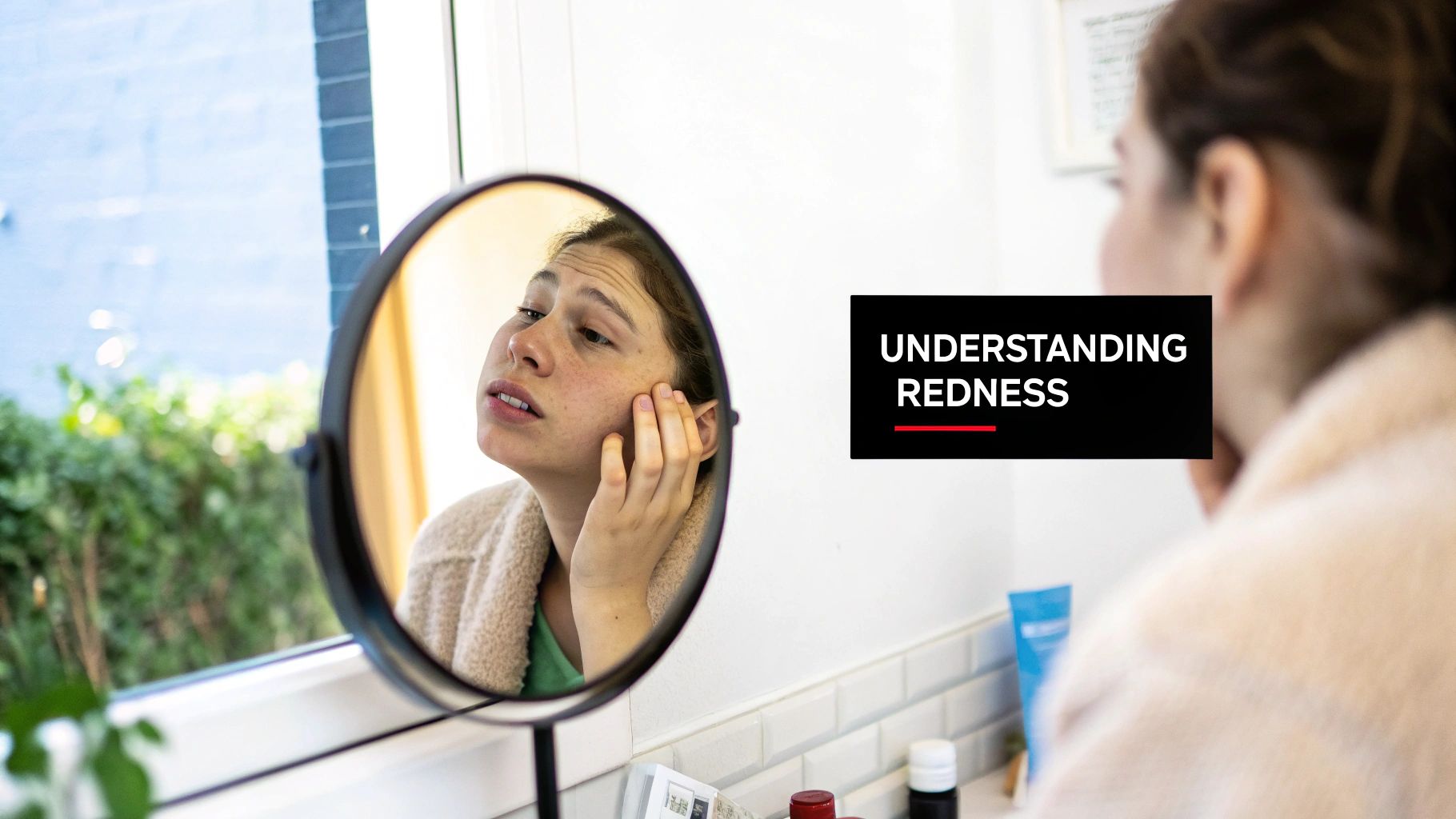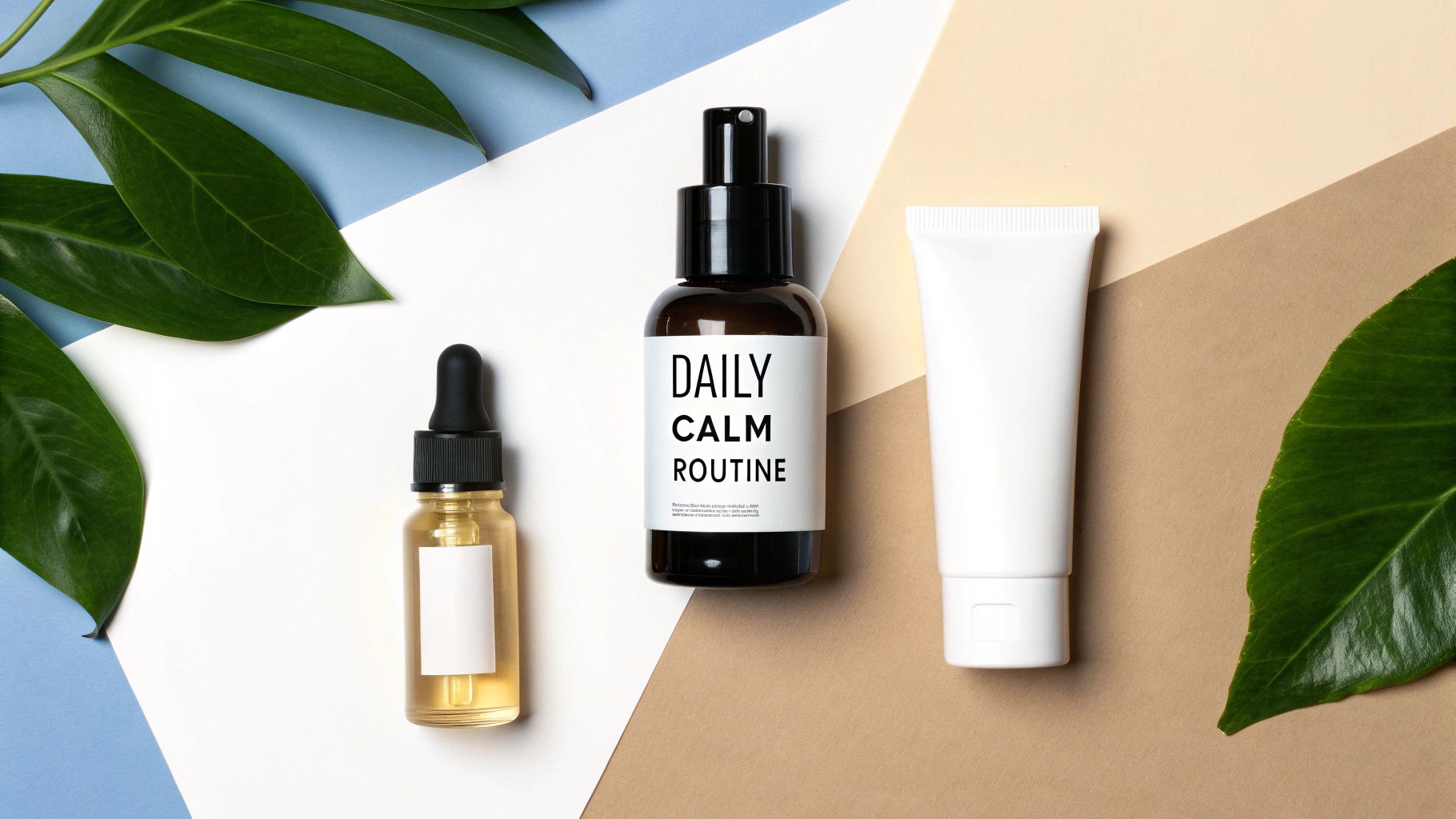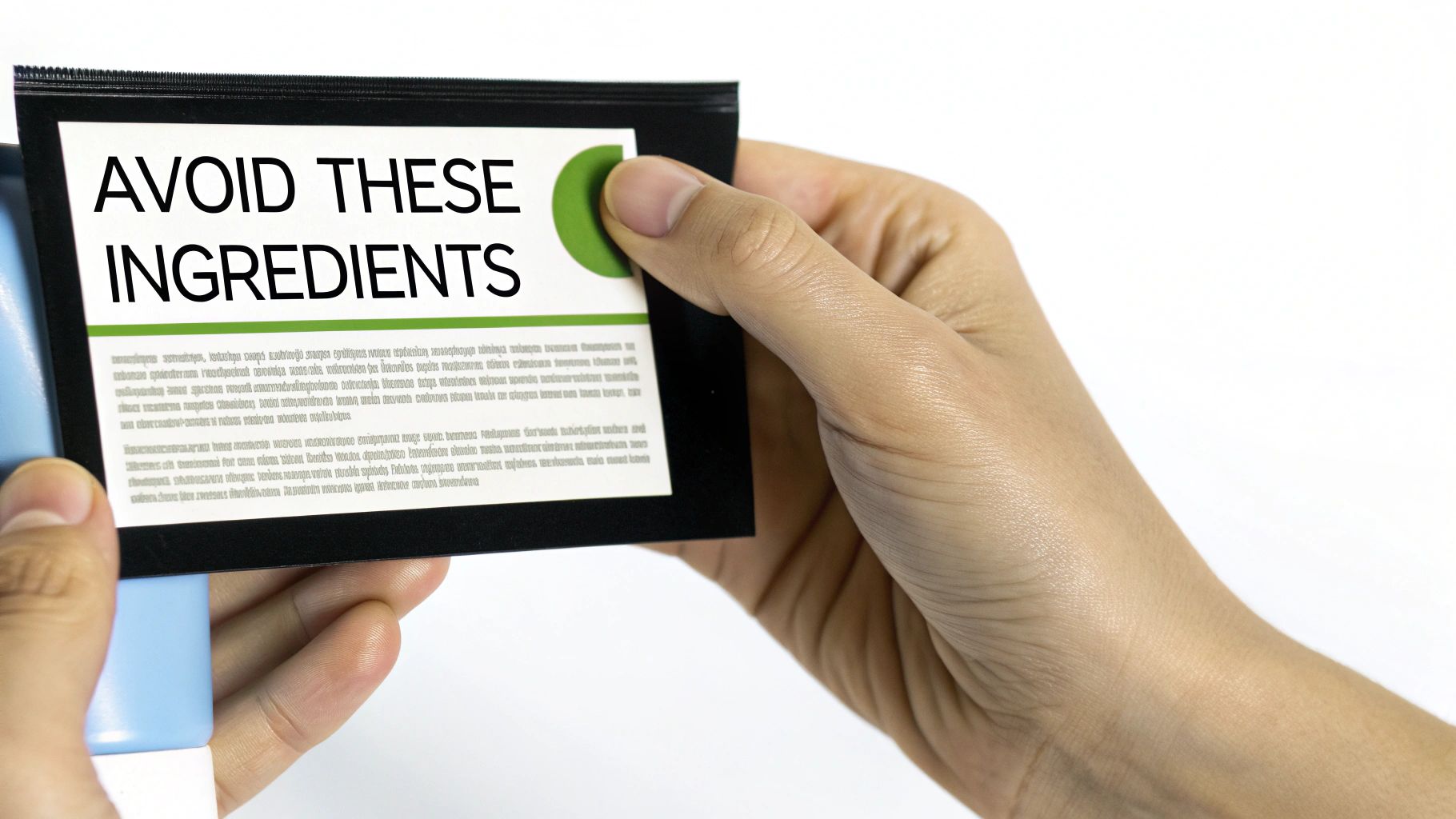Jan Elvis
01.11.2025

Jan Elvis
01.11.2025
Getting facial redness under control really boils down to two things: figuring out what's setting it off and then treating your skin with gentle, targeted care. It's often a process of elimination—identifying triggers like rosacea, sun exposure, or the wrong products—before you can build a routine that actually calms things down and reinforces your skin's natural defenses.

Before you can tackle redness, you have to play detective. Think of facial redness as your skin's way of sending up a flare, signaling that something is out of balance. Sometimes that signal is temporary, like the flush you get after a hard workout. Other times, it's a persistent inflammation that hangs around for days or even weeks.
The trick is learning to tell the difference between a passing flush and something more chronic. I once had a client who was convinced his constant redness was just his natural complexion. It wasn't until we dug into his routine that we pinpointed his morning shave as the culprit. For someone else, it might be a spicy meal, a glass of red wine, or a stressful day at work. Identifying your personal triggers is always the first, most crucial step.
If the redness just won't quit, it often points to an underlying issue or a weakened skin barrier. The usual suspects I see include:
For many people, persistent redness is more than just a cosmetic annoyance—it’s a daily struggle. It’s a clear sign of underlying inflammation that needs a gentle, consistent approach, not an aggressive quick fix.
Rosacea is one of the main reasons people start looking for ways to reduce redness. It’s surprisingly common, with an estimated 16 million Americans living with the condition. This has driven huge growth in the skincare market, with the global rosacea treatment industry projected to hit roughly $3.36 billion by 2032. You can read more about rosacea treatment market trends to see just how widespread the issue is.
On a similar note, simple mechanical irritation from something like shaving can be a major source of redness for many. That's why learning how to shave without irritation is such an essential skill if you're trying to keep your complexion calm and even.

When it comes to calming red, irritated skin, your daily habits are your most powerful weapon. Forget about chasing miracle cures or trying to master some complicated 10-step system. Real, lasting change comes from consistency and using products that genuinely support your skin's health, not attack it.
It all starts with your cleanser. This is a make-or-break step. You need a gentle, pH-balanced, sulfate-free face wash that cleans your skin without stripping it bare. If your face feels tight and squeaky-clean after washing, that’s a major red flag—it means you’ve just damaged your skin's protective barrier, which only invites more inflammation.
Once your face is clean, the focus shifts to putting back the good stuff: hydration and targeted ingredients that will actively calm things down.
This is where you bring in the heavy hitters. Your serums, treatments, and moisturizers are the delivery systems for ingredients proven to soothe irritation and strengthen your skin from within. Just remember to introduce new products one at a time, giving your skin at least a week to see how it reacts before adding another.
Here's a quick guide to some of the best ingredients to look for when you're scanning product labels.
| Ingredient | Primary Benefit | Best Found In |
|---|---|---|
| Niacinamide (B3) | Strengthens the skin barrier and visibly reduces inflammation. | Serums, Moisturizers |
| Azelaic Acid | Calms inflammation, evens skin tone, and is a go-to for rosacea. | Serums, Gels, Creams |
| Centella Asiatica | Also called "Cica," it's a botanical hero for healing and soothing. | Toners, Serums, Balms |
| Ceramides | Rebuilds and reinforces the skin's natural protective barrier. | Moisturizers, Cleansers |
| Green Tea Extract | A powerful antioxidant that helps protect against environmental stress. | Serums, Sunscreens |
Finding a routine that incorporates one or two of these is a great starting point for tackling redness head-on.
I see it all the time: people get excited and throw three new "anti-redness" serums at their face at once, only to make things worse. A simple, consistent routine with one or two well-chosen calming products will always outperform a complex, irritating one.
The final, non-negotiable steps are to moisturize and protect. A good moisturizer, preferably with ingredients like ceramides or hyaluronic acid, will lock in all the good work you've done and help repair your skin's defenses. This makes it far more resilient against future flare-ups.
And every single morning, without fail, finish with a broad-spectrum sunscreen. UV rays are a massive trigger for inflammation and redness, so protecting your skin is non-negotiable.
This fundamental approach works wonders for anyone dealing with redness. For a more detailed guide that puts these principles into action, check out this complete skincare routine for men. At the end of the day, the goal is to work with your skin, not against it.

When you’re trying to calm down facial redness, what you take out of your routine is often more important than what you add in. The secret weapon here is learning how to read an ingredient label. It's your best defense against sneaky irritants that fuel inflammation and undo all your hard work.
So many products, even ones screaming "for sensitive skin" on the bottle, are packed with things that can sabotage your skin's barrier. This can trap you in a frustrating cycle of sensitivity and flushing that feels impossible to break.
I remember a client who couldn't figure out why his skin was always so angry. It turned out to be his "refreshing" mint-infused toner. That cooling sensation he thought meant it was working was actually his skin having a full-blown reaction to menthol. Once he knew what to look for, everything changed.
Here are a few of the biggest troublemakers to watch out for:
Don't make the mistake of trusting a brand name over the ingredient list. Just because a product is popular or expensive doesn't mean it's right for your sensitive skin. The back of the bottle tells the real story.
It’s no surprise the market for chronic skin redness care is booming. It's expected to more than double from USD 3.2 billion in 2025 to USD 7.4 billion by 2035. This massive growth shows just how many people are searching for gentle, effective formulas they can trust. You can read more about the rise of sensitive skincare solutions on futuremarketinsights.com.
Getting familiar with the main irritants is a great first step. To take it further, learning about general skin care ingredients to avoid can help you build a routine that truly supports a calm, happy complexion.

While the right products are a huge piece of the puzzle, they can only do so much. The real secret to tackling facial redness often lies in your daily habits. Think of it this way: your skincare routine is your offense, but your lifestyle is your defense.
It's about creating an environment where your skin can thrive. This doesn’t require a massive life overhaul. For instance, something as simple as the temperature of your shower can make a world of difference. That steaming hot water feels great, but it strips your skin’s protective barrier and dilates blood vessels, causing that instant, beet-red flush. Turning the dial down to lukewarm is a small change with a big payoff.
Ever notice your face gets extra flushed after a specific meal or drink? You're not imagining it. Many of us have personal triggers that set off a reaction. The best way to pinpoint yours is to play detective for a couple of weeks.
Keep a simple diary and note what you eat and drink, and how your skin looks afterward. You’ll probably start to see a pattern.
The point isn't to banish everything you love. It's about awareness. If you know that spicy curry is going to make you red, you can prepare for it or maybe save it for a night when you're staying in.
The mind-skin connection is very real. When you’re stressed, your body pumps out cortisol, the "stress hormone," which can send your skin's inflammatory responses into overdrive. This can worsen everything from rosacea to general sensitivity and blotchiness.
This is why finding a healthy way to decompress is non-negotiable for calm skin. It could be a 15-minute walk at lunch, a quick meditation session, or just putting your phone away for an hour. For a more in-depth look, our guide on how to reduce stress naturally has some great, practical ideas. A calmer mind really does lead to calmer skin.
https://www.youtube.com/embed/15DVWkp0ZAk
Let's be real—sometimes, even the most diligent skincare routine can't quite get stubborn redness under control. And that's perfectly fine. If you've been consistent for a few months but aren't seeing the results you'd hoped for, or if the redness is starting to take a toll on your confidence, it might be time to bring in an expert.
A dermatologist can do something you can't at home: provide a definite diagnosis. They'll help you figure out if you're dealing with rosacea, persistent sun damage, or some form of dermatitis. Getting that professional insight is the best way to stop guessing and start a treatment plan that actually works. Plus, they have access to prescription-strength topicals with higher concentrations of active ingredients, like azelaic acid, that can be true game-changers.
For redness that just won't budge, in-office procedures can deliver impressive results. A dermatologist might suggest treatments that go straight to the source of the problem—those tiny, dilated blood vessels hiding just beneath your skin.
Here are a couple of the most common options:
A professional consultation isn't a sign of failure; it's an empowered next step. It’s about adding an expert to your team to help you achieve the calm, clear skin you deserve.
The demand for effective solutions is skyrocketing. The global market for redness-relief skincare is expected to hit USD 7.8 billion by 2035, fueled by greater awareness and dermatologist-recommended treatments. For particularly persistent cases, professional options like BBL laser treatment can offer significant relief.
When you're dealing with sensitive, red skin, a million questions can pop into your head. It's totally normal. Let's walk through some of the most common ones I hear so you can feel more confident about your next steps.
This is the big one, isn't it? While a soothing cream might feel instantly calming, seeing a real, lasting reduction in redness takes time. You have to be patient as you work to repair your skin's protective barrier.
Think in terms of weeks, not days. Generally, you'll need to stick with a consistent, gentle routine for at least 4 to 8 weeks to notice a visible difference. If you've been diligent for three months and are still struggling, that's your cue to book an appointment with a dermatologist.
It definitely can. If you're using heavy foundations packed with fragrance or alcohol, you might be triggering irritation without even realizing it.
That doesn't mean you have to go bare-faced! Many people find that mineral-based makeup is much kinder to their sensitive skin. The most important things are to choose formulas labeled "non-comedogenic" (meaning they won't clog your pores) and to be incredibly gentle when you take it all off at the end of the day.
A key takeaway: It’s often not the makeup itself that's the problem. The real culprit can be the combination of irritating ingredients and the aggressive rubbing it takes to remove it.
Not always. While rosacea is a very common cause of that persistent, flushed look, it’s not the only possibility. Your redness could also be a sign of:
Look for other clues. Are there bumps? Is there a burning or stinging sensation? These details can help point you in the right direction. But for a true diagnosis, a dermatologist is your best resource. They can properly identify the cause and set you up with a treatment plan that actually works.
At Main Character, we get it. Feeling good in your skin is the ultimate confidence booster. Our products are made with gentle, effective ingredients to support your skin's health, helping you build a simple routine that brings you calm, clear results. Start your journey to calmer skin today.